A wholesome stew made in simple steps, braised beef with daikon is a classic Chinese dish perfect for both weekday dinners and special gatherings.
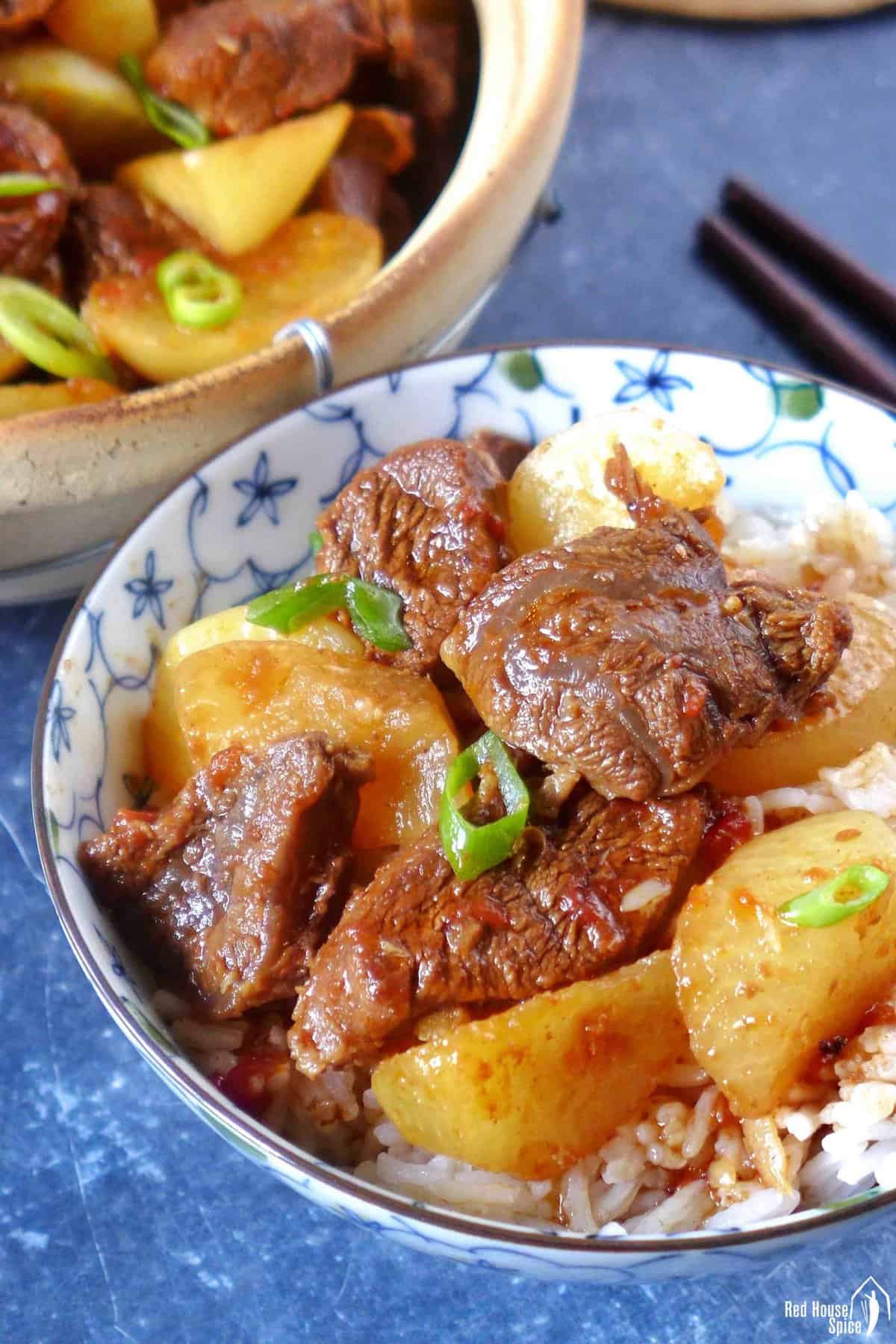
Jump to:
About the dish
Recently, I’ve been craving hearty stews and soups as the weather turns chilly. Apart from Beef & Potato Stew and Pork Rib Soup, a dish my dad frequently cooked when I was young came to mind — Braised Beef with Daikon (Luó Bó Dùn Níu Ròu/萝卜炖牛肉). Cooking and eating it has brought me so much comfort, and my family enjoyed it immensely as well.
My son asked: “Which regional cuisine does this dish belong to?” As far as I know, this dish is popular across China, in both restaurants and family homes. With beef and daikon being the key components, different versions vary in seasoning choices. For example, Sichuan chefs would add a dollop of Doubanjiang/豆瓣酱 for an aromatic heat (similar to my recipe for Spicy Beef Noodle Soup), while the Cantonese version calls for a special sauce called Chu Hou Paste/柱侯酱.
The recipe I’m sharing today uses a set of basic condiments and spices commonly found in meat-based Chinese stews, such as Red Braised Pork Belly. They create highly aromatic, complex flavors that work wonderfully with tender beef and soft daikon. Every bite is a delight, I promise!

Top Tips
- Beef shank or brisket are ideal cuts
- Daikon can be replaced by other vegetables, such as carrots, potatoes, winter melon, etc.
- Use a cast iron casserole if available. An Instant Pot is even better
- Make a big batch and store it in portions for later use
Ingredients
Here is the list of ingredients you need for this recipe:

- Beef shank (shin) or brisket. Both offer a balance between tender meat, a gelatinous mouthfeel, and a fibrous yet flavorful bite, making them perfect for slow-cooked braising dishes. Plus, they’re economical choices.
- Daikon, also known as white radish or mooli. Choose the ones with smooth, tight-looking skin that feels firm when gently squeezed.
- Aromatics: ginger and garlic
- Chopped tomato. It adds extra flavor, and its acidity helps tenderize the meat.
- Spices: star anise, bay leaves, cassia cinnamon, and Sichuan pepper. It’s fine to skip one or two spices. If you don’t have whole spices, use ½ teaspoon of five spice powder to substitute.
- Condiments: light soy sauce, dark soy sauce, oyster sauce, Shaoxing rice wine, salt, white pepper, and sugar
- Garnish: scallions or cilantro (coriander)
NOTE: See the recipe card at the end of the post for ingredient quantities.
Cooking procedure
Step 1: Blanch the beef
Cut the beef into large cubes, about 1 inch (2½ cm) on each side. Then put the pieces into a pot filled with cold water.
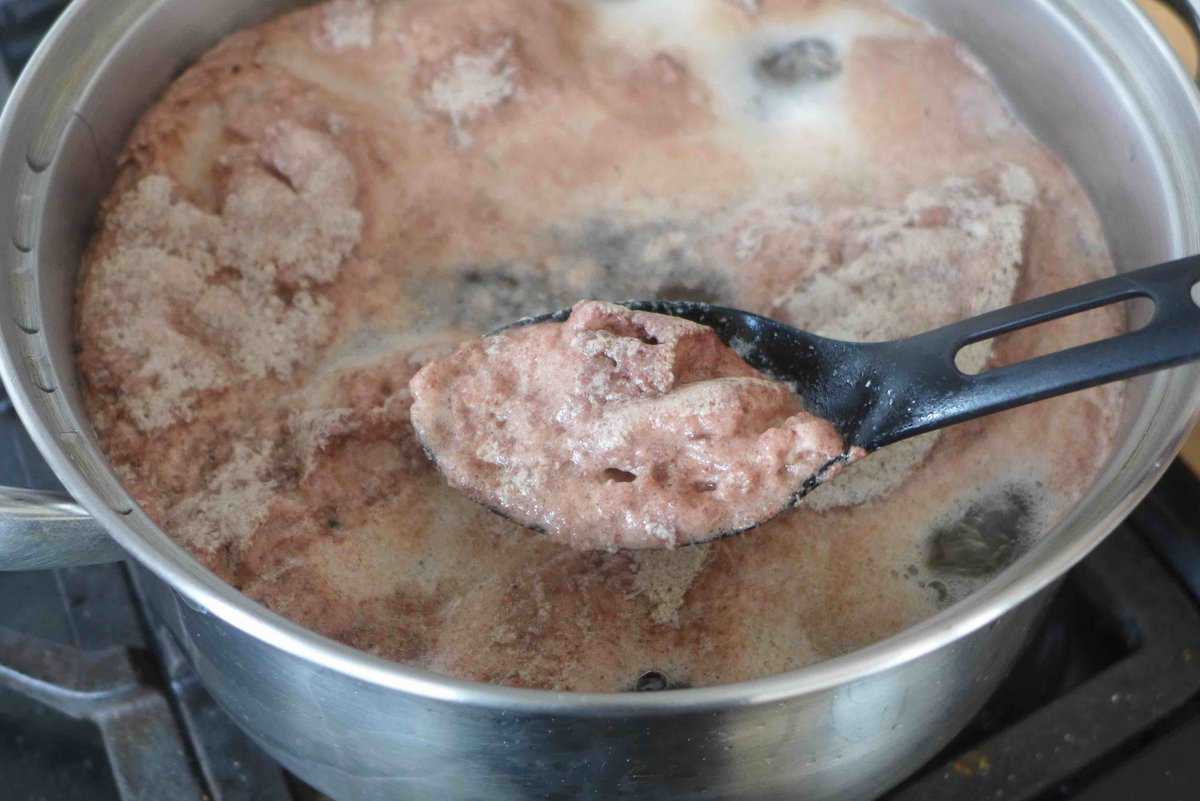
First, bring it to a boil. Then leave the water to roll for about 2 minutes. Use a spoon to skim off any brown foam on the surface.
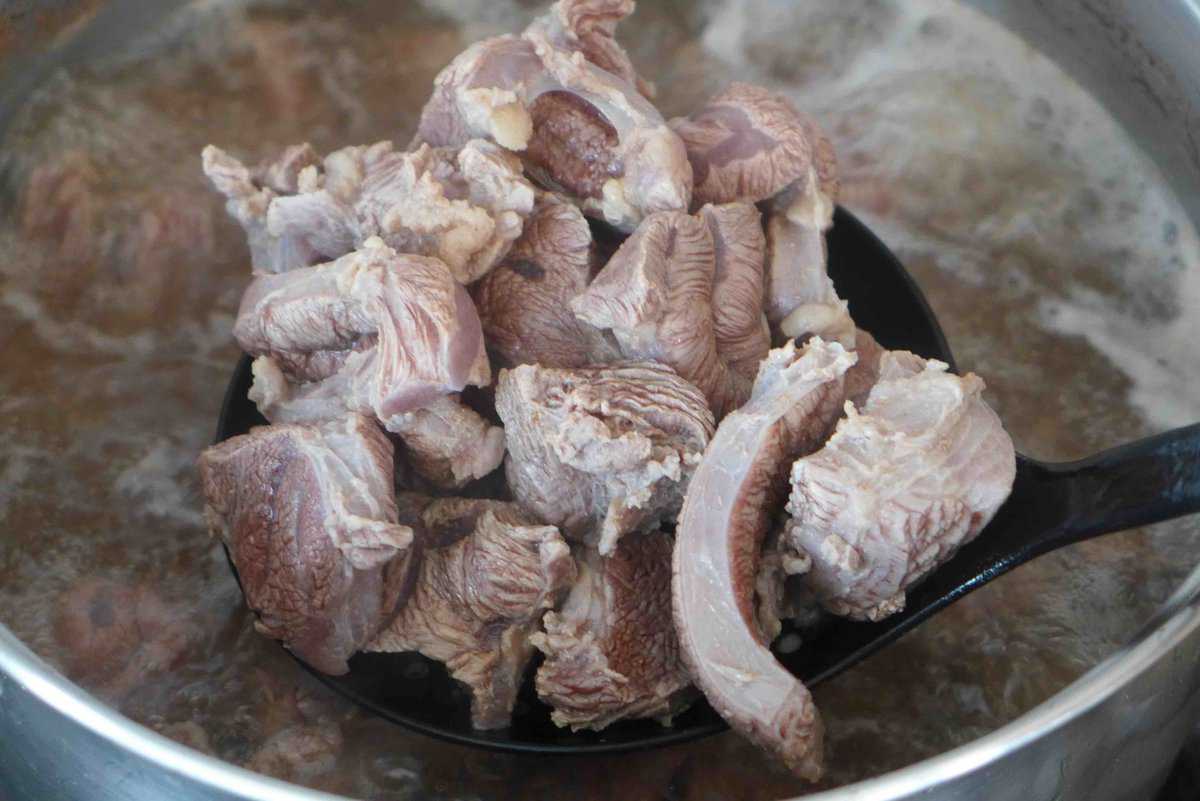
Then, fish out the beef and discard the water.
🌟 NOTE: Unlike blanching vegetables like broccoli, it’s important to start by putting the beef in cold water to slowly draw out blood and impurities for a clearer broth. Starting with hot water causes the proteins to coagulate quickly, making the meat tougher.
Step 2: Braise the beef
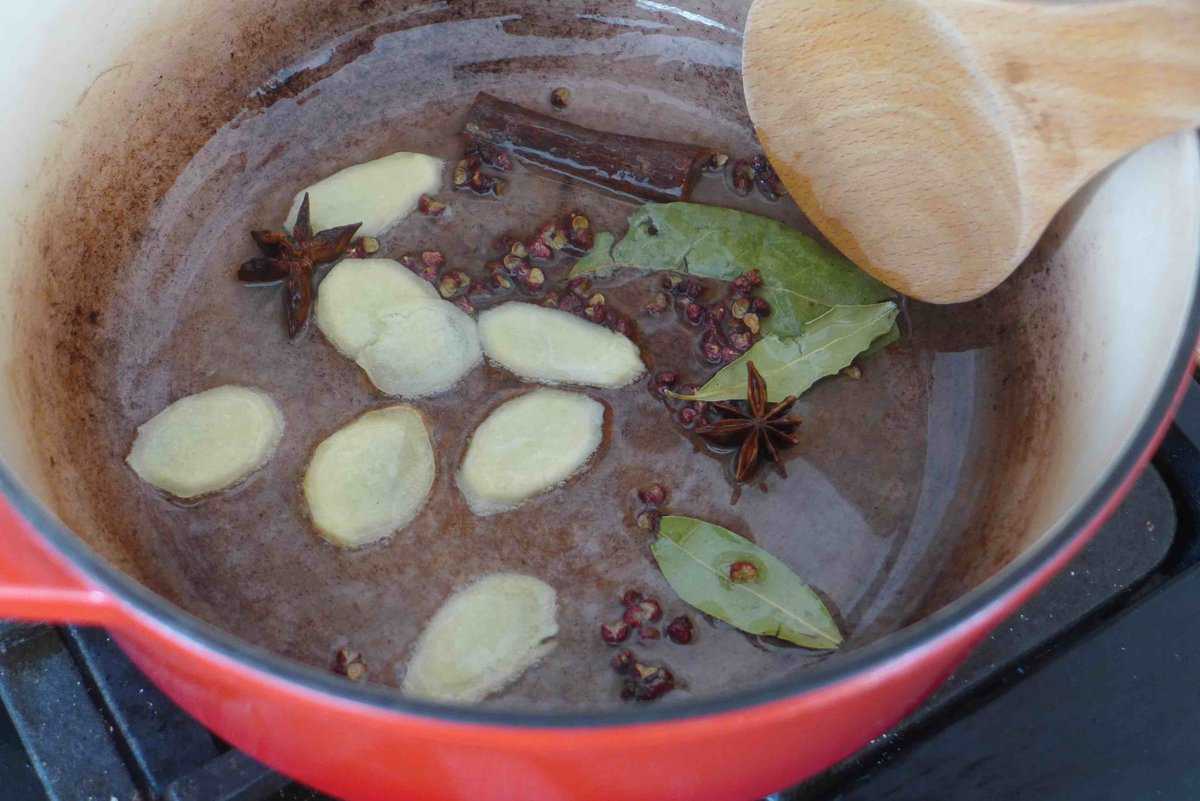
For the braising part, use a pot that maintains heat well and comes with a tight lid (e.g. a cast iron casserole). Firstly, sizzle ginger and the spices in a little oil over low heat to slowly extract their aroma.
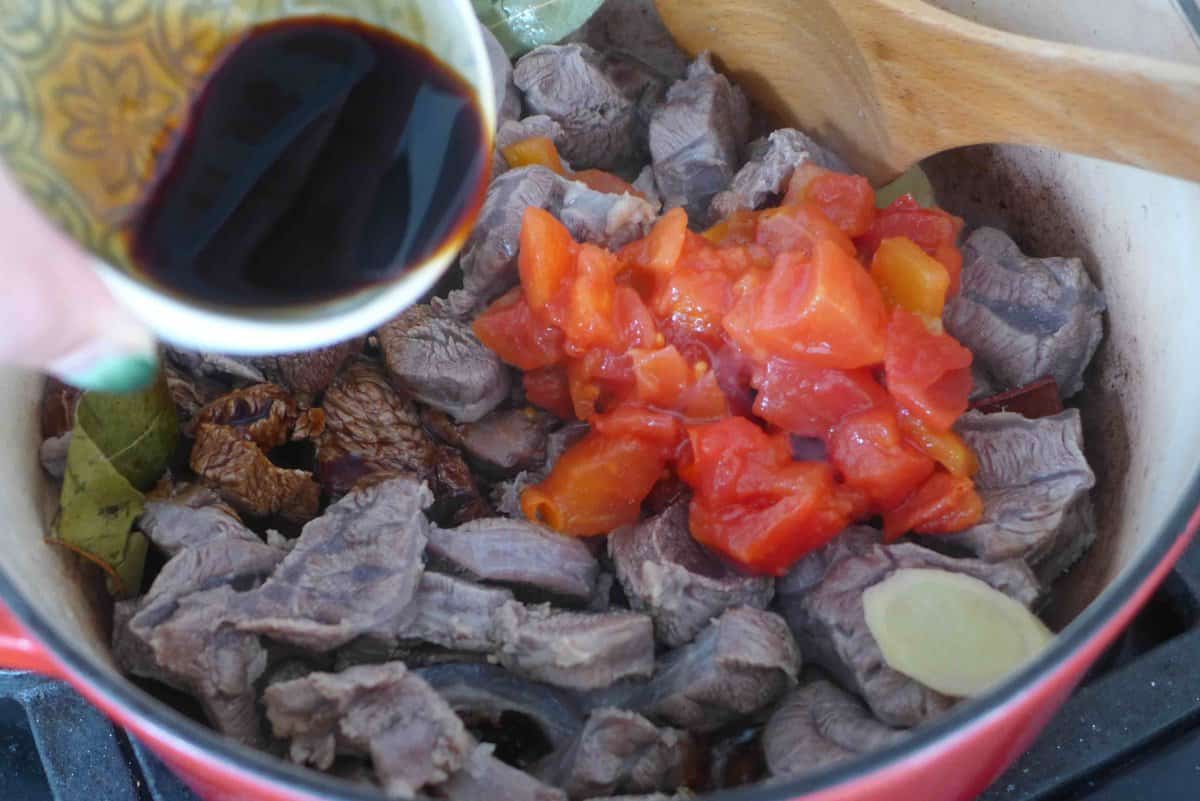
Then tip in the blanched beef. Fry over high heat for a couple of minutes. Add chopped tomato, along with all the condiments.
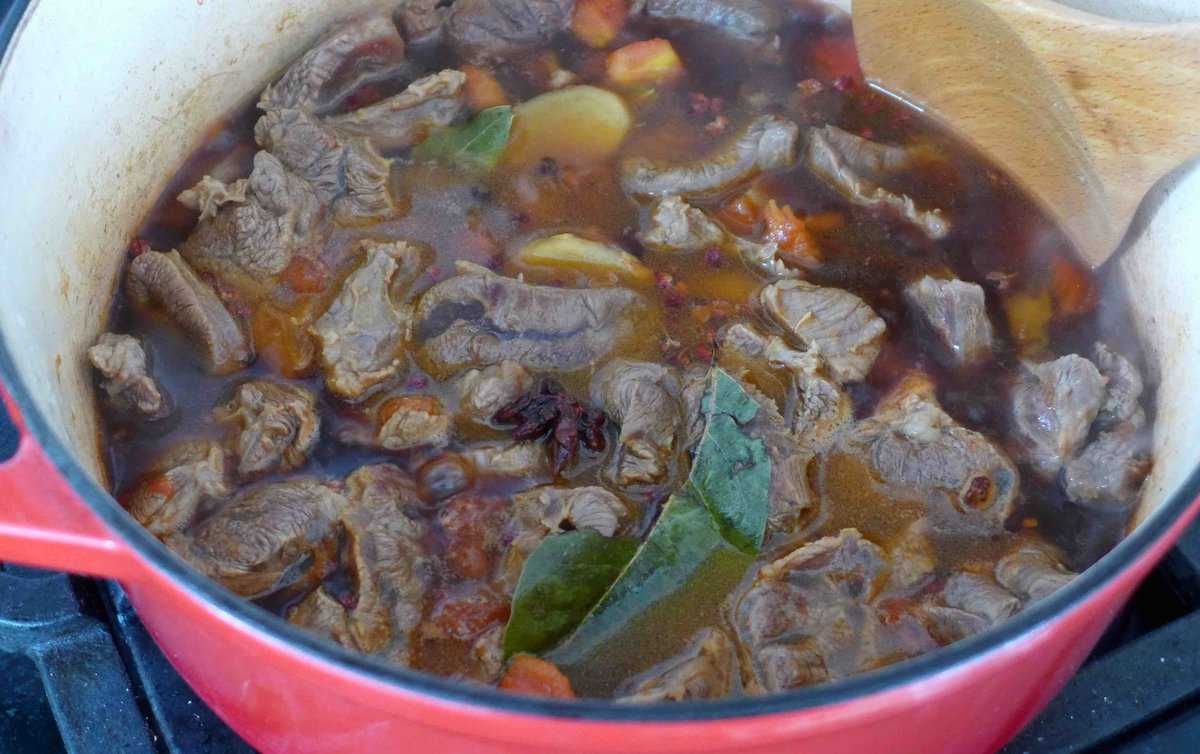
Pour in hot water, then give everything a good swirl. Once the water starts boiling, reduce the heat to the lowest.
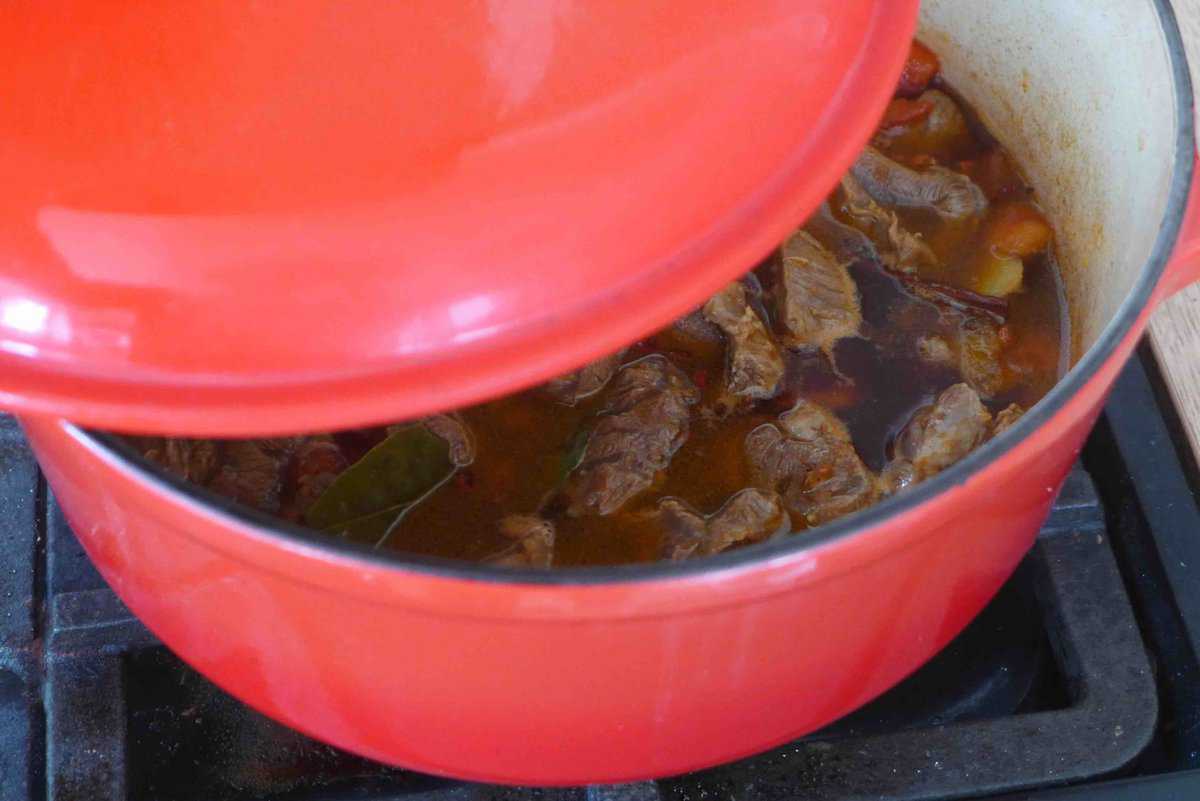
Cover the pot with a lid and let it simmer for 60 to 90 minutes until the meat achieves the tenderness that you prefer.
🌟 NOTE: Remember to check the water level halfway through this step. This is especially important if the pot lid isn’t tight enough, as it may allow excessive water evaporation. Add more water if necessary.
Step 3: Cook the daikon
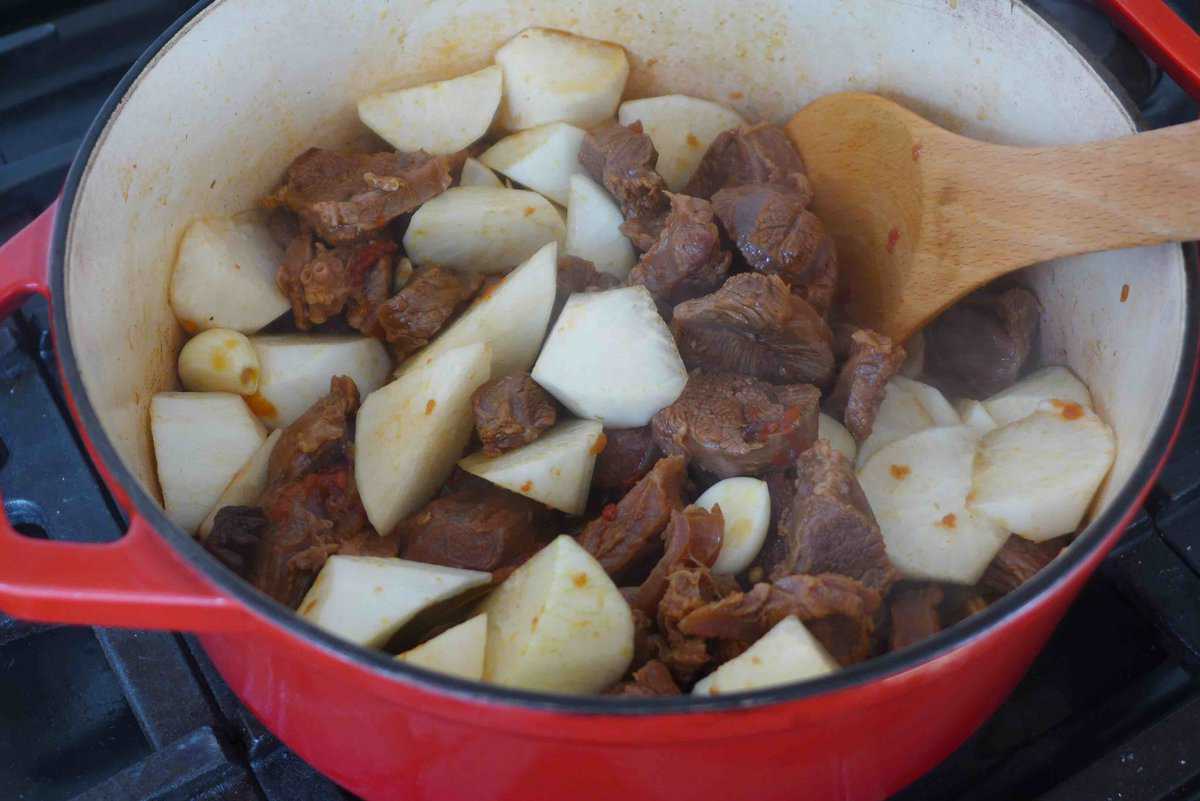
Once the beef is tender, add the chopped daikon and garlic cloves. Mix well then leave to cook over medium heat for about 15 minutes, until the daikon becomes very soft and absorbs some of the broth.
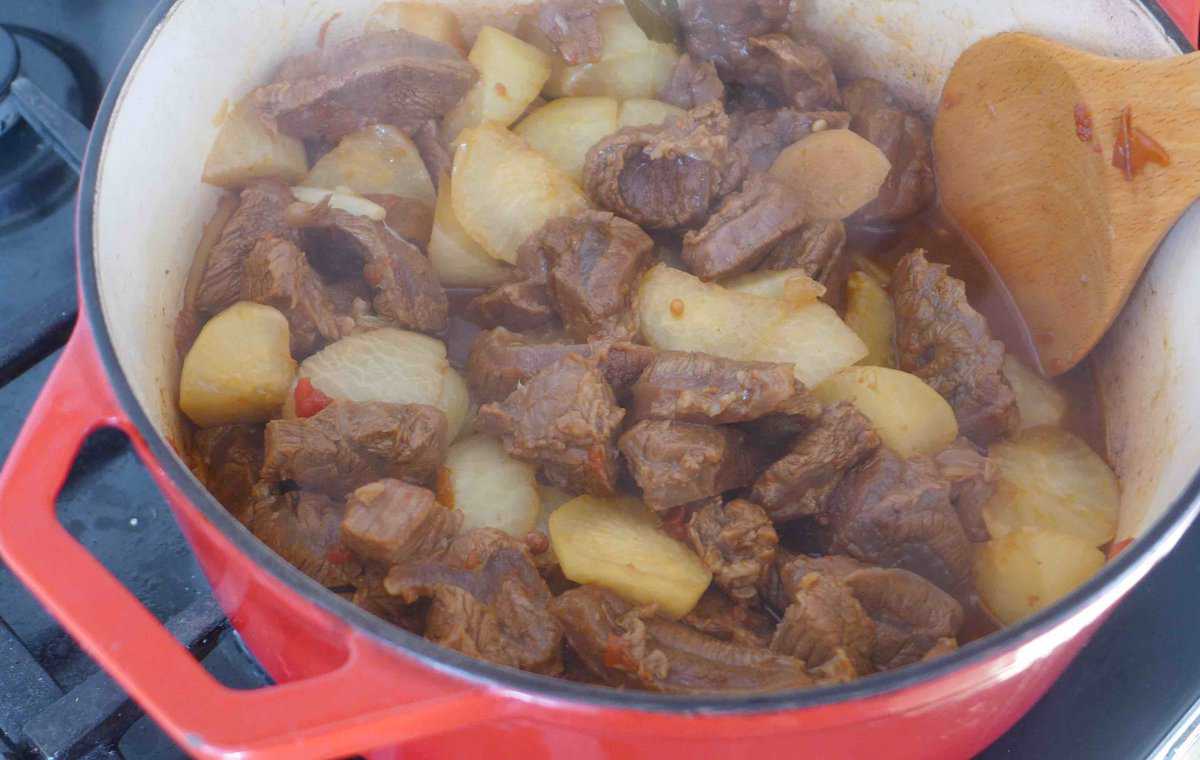
If you prefer a thick, more intensely flavored broth, turn up the heat and cook a little longer with the pot uncovered.
Finally, give the dish a taste to decide if additional salt is necessary. Garnish with chopped scallions or cilantro before serving.
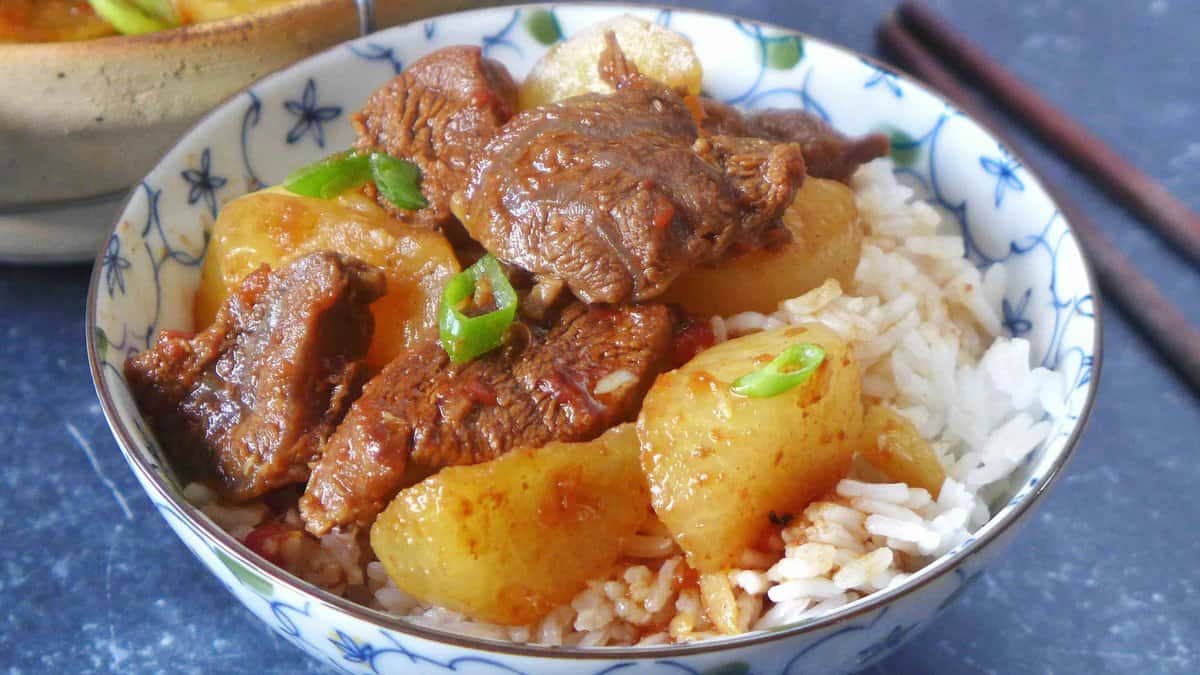
Instant Pot method
If you own an Instant Pot or a pressure cooker, you can speed up the braising process by following this procedure:
- After blanching, fry the spices and the drained beef in a little oil using the “sauté” function.
- Add chopped tomato, all the condiments, and hot water (a little less than using a regular pot). Cook on high pressure for 25 minutes followed by a natural release of the pressure.
- Put in daikon and garlic. Cook on high pressure for a further 5 minutes.
Storage & make ahead
Keep any leftover in an airtight container in the fridge for up to 3 days. Reheat it until piping hot before serving.
If you plan to make this dish in big batches and serve later, blanch and braise the beef as instructed. Store it in the freezer, divided in portions, for up to 3 months. Defrost the amount you need and cook with fresh daikon.
📋 Recipe card
Love this recipe? Please leave a 🌟🌟🌟🌟🌟 rating and a comment. Thank you!
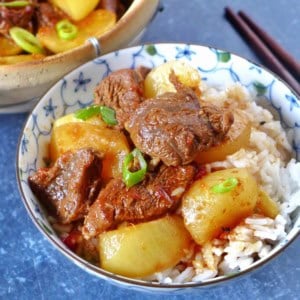
Braised Beef with Daikon (萝卜炖牛肉)
Ingredients
- 2 lb beef shank - or beef brisket
- 1 tablespoon neutral cooking oil
- 6 slice ginger
- 2 star anise - see note 1
- 3 bay leaves
- 1 piece cassia cinnamon
- 1 teaspoon whole Sichuan peppercorn
- ½ cup chopped tomato
- 1 tablespoon light soy sauce
- 1 tablespoon dark soy sauce
- 1 tablespoon oyster sauce
- 1 tablespoon Shaoxing rice wine
- 1 teaspoon sugar
- ¼ teaspoon salt
- ⅛ teaspoon ground white pepper
- 1 lb daikon - aka white radish, mooli, cut into chunks
- 10 cloves garlic - peeled
- Scallions - or cilantro (coriander)
Instructions
Blanch the beef
- Cut the beef into bite-sized cubes. Put them into a pot and fill it with plenty of cold water.
- Bring the water to a full boil. Let it boil for a couple of minutes while skimming off any foam appearing on the surface. Drain the beef and discard the water.
Braise the beef
- Pour oil into a clean pot. Add ginger slices, star anise, bay leaves, cassia cinnamon, and Sichuan pepper. Sizzle them over low heat until fragrant.
- Stir in the drained beef chunks and fry for a minute or so. Add chopped tomato, light soy sauce, dark soy sauce, oyster sauce, Shaoxing rice wine, sugar, salt, and white pepper. Pour in about 1½ cups (360ml) of hot water, or just level with the meat.
- Bring the water to a boil then turn down the heat to low. Cover the pot with a tight lid and let it simmer for 1 to 1½ hours, until the meat turns tender (see note 2 for the Instant Pot method).
Cook the daikon
- Stir in the daikon pieces and garlic cloves. Cover the pot and leave to cook over medium heat for another 15 minutes or so, until the daikon becomes soft to bite.
- Optionally, cook a little longer over high heat without the lid if you wish to reduce and thicken the broth.
- Transfer the dish to a serving bowl/plate. Garnish with scallions or cilantro and serve immediately.
NOTES
- Fry spices and blanched beef in a little oil using the “sauté” function.
- Add chopped tomato, all the condiments, and hot water (a little less than using a regular pot). Cook on high pressure for 25 minutes followed by a natural release of the pressure.
- Put in daikon and garlic. Cook on high pressure for a further 5 minutes.
NUTRITION
NUTRITION DISCLOSURE: Nutritional information on this website is provided as a courtesy to readers. It should be considered estimates. Please use your own brand nutritional values or your preferred nutrition calculator to double check against our estimates.




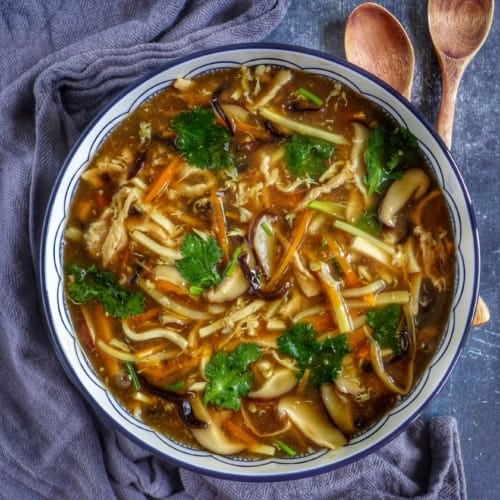

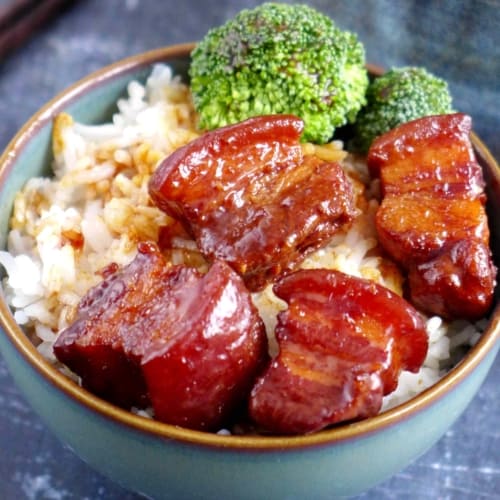
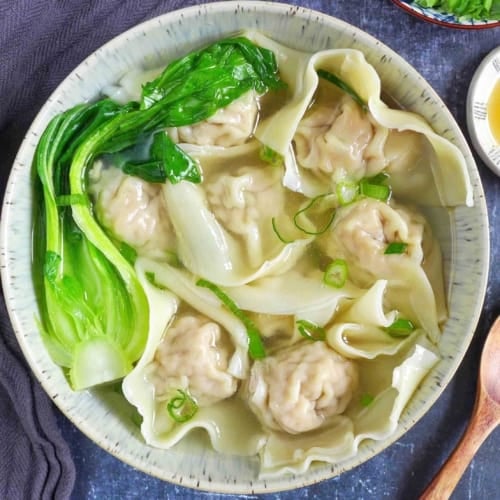
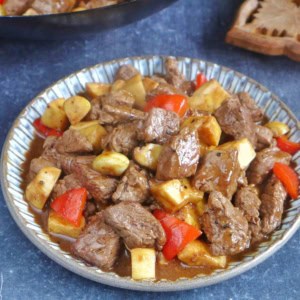
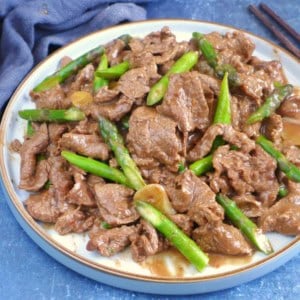


Hi Wei,
Would this braising marinade work for pork instead of beef and could we sub in pork instead of beef here? I always love how balanced and complex your sauces are. Thanks so much!
Michelle
Yes, Michelle, pork can be used as a substitute in this recipe. Just remember not to use very lean cuts of pork, as a bit of fat will enhance the flavour and prevent the meat from tasting too dry. Happy cooking!
I had similar dishes when visiting friends in China. Always wanted to make it myself. Your recipe is so easy to follow. And it tastes even better than I remembered. Will cook it again
Thank you for the lovely comment, Pauline! Glad my recipe brought back fond memories of your time in China. It’s amazing to hear that it even surpassed your expectations—that truly makes my day! I hope you enjoy making it again and again.